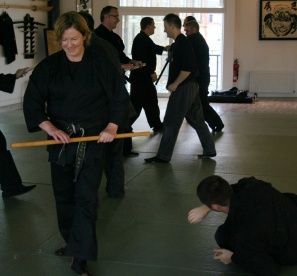With 38 years of martial arts under (several) black belts, Gillian Booth is one of the highest-ranking shidoshi in Bujinkan Budo Taijutsu.
She is also surely one of the most deadly, as a former national champion of Judo and 15th Dan rank in Bujinkan, along with yellow belts in a smattering of other martial arts.
In the first part of my interview with her, she spoke about her training career in Judo and Bujinkan, what inspires her, and why we should use ‘the force’… but not too much.
Gillian is not the first instructor to find Bujinkan via a career in Judo. But she may be one of the most interesting.
Her martial arts career began with the sport martial art – and almost finished with it. She admits it’s “a very harsh sport”.
“It’s a bit like rugby – only you can’t run away with the ball. You just have to keep holding on – tackling each other, trying to throw each other. I mean, how many 35-year old professional rugby players are there? You’ll find few people very active in Judo in their thirties. Most are a bit broken and injured and can’t continue to train.
After fifteen years and two serious injuries, she found herself in the “bit broken” category and retired from Judo. Her addiction to the feeling of flow and nagare – “the battle of wits and minds and bodies” kept her flirting with martial arts, picking up grades in Hapkido, Kung Fu, and Aikido.
By the time her partner recommended she try Ninjutsu, she was almost ready to hang up all the belts. But she went along anyway and loved it. She found a lot of parallels between Bujinkan and Judo.
“There was a lot of similar feelings; a lot of similar angles and timing and distance and rolling and ukemi. Bujinkan gave me the opportunity to use everything I had ever learned in Judo, but to also have a curriculum that was inexhaustible. There was so much to learn.
The was also a stark difference at training level:
“In Bujinkan there was a little bit of discomfort and inconvenience and injury risk, but it wasn’t like being run over by a bus every time you went to training.
The physical impact on the body came down to the different use of power and force.
“The striving we have in our art is to always look for that sweet spot using the least amount of power – it’s not how you can force the sweet spot with a lot of power.

It’s the sweet spot that explains how those with less traditional strength can be so powerful at Bujinkan. She points out that there are people still training at 70 or 80 years old, and women training, who have found their way in the dojo by using less energy, less power and being smarter about how they move.
It’s encouraging talk for anyone who is not 22, 50% muscle mass and able to bench press twice their weight. In fact, employing your natural strength could ultimately be counterproductive, she says.
“Whenever you’re training and you feel like you have to use power to affect something – try use less instead of more. Think ‘how can I cut back the power and get this to work instead of trying harder?’ Or ‘how can I manoeuvre my body or manipulate the timing or the distance so that I use less power?’
She advises not to try meet force with force, or strength with strength.
“Redirect that force, and if you can get that mental mindset and adapt that to your body movement, not only will your skill level sky-rocket, your longevity will also increase.
There is no higher example than 81-year old grand master Hatsumi Sensei, who she describes as an “amazingly inspiration” along with his senior teachers.
“They’re very inspirational, not just because they’re great at budō, but because they are creative human beings and old men who are still very active and still enjoying what they do. They’ve still got that sense of childlike fun in what they do.
As she enthralled her audience of students at the Dublin seminar, kyu grades and 15th Dans among them, it’s clear she is still enjoying herself too. After 38 years of the male-dominated, injury-prone and challenging world of martial arts, she still manages to stay inspired and in turn be inspirational.
Those who she used as uke at the seminar told me they barely felt pressure from her fingers as she twisted and threw them into submission. She told us that, on a 1 to 10 table of force, her teachers in Japan seem to work at a zero. She considers herself only able to manage one or two.
With her ‘use the force – but not too much’ mantra, it’s clear she does practise what she preaches. Let’s hope she continues to do so for another 20 years.
Read the Gillian Booth interview Part II.
Train with Gillian in her Courageous Heart dojo in Sydney.
